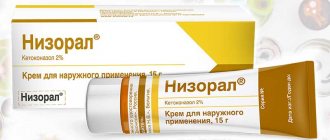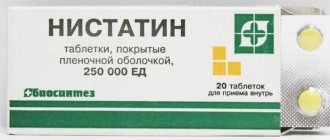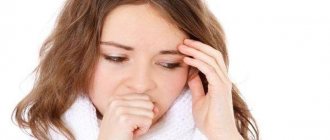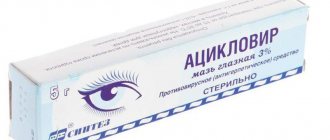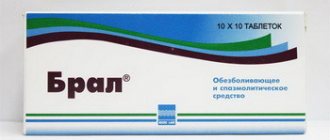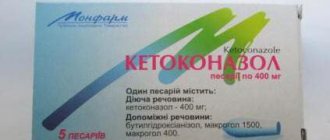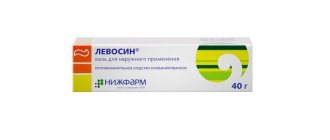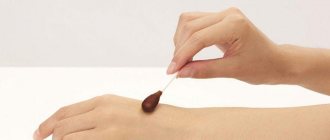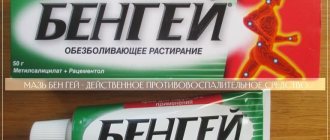Write a review
Reviews: 0
Active ingredients
- Ketoconazole
Disease class
- Seborrheic dermatitis
- Other specified follicular diseases
- Septicemia, unspecified
- Cutaneous leishmaniasis
- Dermatophytosis
- Mycosis of the beard and scalp
- Mycosis of nails
- Tinea versicolor
- Candidiasis
- Candidiasis of the skin and nails
- Candidiasis of the vulva and vagina (N77.1*)
- Coccidioidomycosis
- Histoplasmosis
- Blastomycosis
- Paracoccidioidomycosis, unspecified
- Mycosis, unspecified
Clinical and pharmacological group
- Not indicated. See instructions
Pharmacological action
- Antifungal
Pharmacological group
- Antifungal agents
Compound
- 1 tablet of Nizoral contains approximately 200 mg of ketoconazole . Additional substances: polyvidone K90, lactose monohydrate, microcrystalline cellulose, magnesium stearate, corn starch, silicon dioxide, water.
- Nizoral shampoo contains 20 mg of ketoconazole per 1 gram of product. Additional substances: collagen hydrolyzate, sodium lauryl sulfate, coconut oil diethanolamide, disodium lauryl sulfosuccinate, macrogol methyl dextrose dioleate, hydrochloric acid, red dye, sodium chloride, imidourea, sodium hydroxide, flavoring, water.
- 1 gram of the cream of the same name includes 20 mg of ketoconazole . Additional substances: propylene glycol, sorbitan stearate, cetyl alcohol, stearyl alcohol, polysorbate 60, isopropyl myristate, polysorbate 80, sodium sulfite, water.
The principle of action of the drug
Nizoral shampoo is an effective antifungal agent for external use. He can safely be considered a time-tested expert in the fight against dandruff. Not every drug can boast such a long history in the pharmaceutical market. The drug first became known in 1976, and to this day it manages to remain popular and in demand in the fight against an unpleasant defect.
The drug can not only eliminate cosmetic problems of the scalp, but also eradicate the cause of their occurrence. The product contains ketoconazole. This substance inhibits the growth and promotes the death of harmful microorganisms, fungi, which provoke the development of pityriasis versicolor and seborrheic dermatitis.
The manufacturer recommends using Nizoral shampoo for:
- dandruff;
- seborrheic dermatitis;
- pityriasis versicolor.
In addition to shampoo, the manufacturer offers Nizoral tablets and cream. Many experts claim that the cream guarantees greater effectiveness because it stays in contact with problem areas of the scalp longer. But in tablets the concentration of the active ingredient is the highest - 200 mg per 1 capsule.
Composition and benefits
Nizoral anti-dandruff remedy is a red-orange liquid, thick in consistency, with a specific odor. The main active ingredient is ketoconazole, in a proportion of 20 mg per 1 g of shampoo. Ketoconazole particles penetrate every cell of the harmful fungus, stop its growth and destroy the cell membrane, making them defenseless and weakened.
For deep and high-quality cleansing of the scalp from accumulated dandruff flakes, surfactants (surfactants) are added to the composition. These include coconut oil fatty acid diethanolamide and disodium lauryl sulfate.
To stabilize the acid-base balance and complement the antimicrobial effect of the product, the composition contains hydrochloric acid and imidourea. It is impossible to miss the presence of cosmetic fragrances, flavors and dyes in the preparation.
Important point! Despite the rich synthetic composition, Nizoral shampoo can be used during lactation and pregnancy.
Advantages and disadvantages
Among the advantages and positive qualities of the Nizoral product, experts and users note:
- highly effective in combating fungal diseases of the scalp, confirmed by 64 clinical studies and user reviews;
- affects the problem from the inside, having a detrimental effect on the causative agent of the disease;
- suitable for the treatment and prevention of dandruff in the hair;
- can be used during lactation and pregnancy, for the treatment of children and adolescents;
- has a minimum of contraindications;
- foams well;
- easy to use;
- Sold in a pharmacy, dispensed without a doctor's prescription.
Of the negative qualities, users noted:
- high cost of the drug;
- the composition contains dyes, fragrances, disodium lauryl sulfate and a number of other synthetic additives that can cause side effects and an allergic reaction;
- lack of natural nutritional supplements, oils and plant extracts that would soften the aggressiveness of the chemical composition and active substance;
- can give bleached and gray hair an extraneous tint. To eliminate it, just wash your hair with regular shampoo.
Price
The cost of Nizoral is quite significant. The shampoo is available in volumes of 25, 60 and 120 ml. For the purchase of a small bottle you will pay from 750 rubles.
The product is used sparingly. For example, one package is enough for 1.5–2 months when treating seborrheic dermatitis. If Nizoral is intended for pityriasis versicolor, it is advisable to purchase a large package.
It is strictly prohibited to use a product that has expired.
Contraindications
Individual intolerance to the components of the drug is the main limitation for the use of Nizoral products. Otherwise there are no contraindications.
Before first use, test the composition for allergies. To do this, apply a few drops of the product to sensitive skin. The appearance of a strong burning sensation, redness at the site of contact with the drug is an allergic reaction, this product should not be used.
Risks of use during pregnancy and lactation
As for the treatment of dandruff and skin diseases in women during pregnancy, there is no data on harm caused to the baby in the womb. Given the aggressiveness of ketoconazole, when prescribing the drug, the expected therapeutic effect is compared with possible harm to the health of the fetus.
For nursing mothers, the use of Nizoral shampoo is also not contraindicated. The only point is that if an allergic reaction occurs in the baby, the use of the drug is stopped. Avoid contact of the product with the mammary gland.
Release form
- White flat tablets, round in shape, with beveled edges, on one side with the inscription “JANSSEN“, on the other - with a serif and the inscription “K 200“. 10 tablets in a blister, 1 or 3 blisters in a paper pack.
- Nizoral shampoo 2% is a red-orange liquid. 25, 60 or 125 ml of liquid in a polyethylene bottle, 1 bottle in a paper pack.
- Nizoral 2% cream is white in color and has a uniform consistency. 15 grams of cream in aluminum tubes, 1 tube in a paper pack.
Which is better: Nizoral or KETO PLUS
Shampoo KETO PLUS.
Photo: ketoplus.ru The drugs are not analogues of each other. Active ingredient of Nizoral: Ketoconazole. Produced in the form of a cream for external use and medicinal shampoo 2%. KETO PLUS is a combined antifungal drug with the active ingredients: Ketoconazole and Pyrithione zinc. Produced in the form of shampoo. Indications:
- pityriasis versicolor;
- seborrheic dermatitis;
- various types of dandruff.
Thanks to the presence of zinc pyrithione in the KETO PLUS preparation, skin flaking and itching are quickly eliminated, because it is active against Pityrosporum ovale and Pityrosporum orbiculare, which cause excessive peeling of the skin. Both drugs are available without a doctor's prescription!
The country of origin of Nizoral is Belgium. KETO PLUS is produced in India. The cost of KETO PLUS is more expensive than Nizoral. Price per bottle from 398 rub.
Pharmacodynamics and pharmacokinetics
Pharmacodynamics
Ketoconazole is a synthetically produced imidazole-dioxolane that exhibits fungicidal effects against dermatophytes, yeasts (Torulopsis, Malassezia, Cryptococcus, Candida), dimorphic fungi and eumycetes (higher fungi). Least sensitive to the effects of ketoconazole : Sporothrix schenckii, fungi of the genus Aspergillus, some representatives of the genera Dermatiaceae, Mucor and other phycomycetes , except Enomophthorales. The active substance of the drug inhibits the synthesis of ergosterol in fungal cells and changes the composition of a number of membrane lipid components.
With a therapeutic daily dose of 200 mg, Nizoral tablets can temporarily reduce the concentration of testosterone in the blood. Testosterone concentration returns to its original value one day after using ketoconazole . When carrying out long-term treatment using the indicated dosage, testosterone usually differ little from normal.
Ketoconazole tablets at a dose of 400 mg per day and above can weaken the “cortisol response” to activation by adrenocorticotropic hormone in volunteers.
Nizoral 2% ointment quickly relieves itching due to yeast and dermatophyte infections, and symptomatic improvement is detected even before the first symptoms of recovery appear.
2% anti-dandruff shampoo Nizoral actively reduces flaking and itching that usually accompany seborrheic dermatitis , pityriasis versicolor , and dandruff .
Pharmacokinetics of Nizoral cream and shampoo
The content of ketoconazole in the blood after local application of the cream to the skin of adult patients was not determined. With repeated application of the cream in large volumes in children (over 3 grams), the likelihood of developing drug interactions by suppressing the metabolism of drugs transformed by CYP3A4 enzymes allergic phenomena is also possible .
Concentrations of ketoconazole in the blood after local application of shampoo to the scalp are not determined.
Pharmacokinetics of Nizoral tablets
Ketoconazole is a weak dibasic substance that dissolves and is absorbed in an acidic environment. The highest level of ketoconazole in the blood is achieved 1-2 hours after taking 200 mg of the drug orally with food.
Reaction with plasma proteins (mainly with the albumin fraction ) reaches 99%. It is actively distributed throughout the tissues, but only a small part of the drug penetrates into the cerebrospinal fluid.
Metabolized in the liver by oxidation, oxidative dealkylation, destruction of piperazine and imidazole rings and aromatic hydroxylation with the release of a large number of inactive metabolites. The main methods of metabolism are oxidation and breakdown.
The half-life is approximately 10 hours. Approximately 13% of the dose is evacuated in the urine, the remainder is excreted in bile into the intestines.
Pharmacotherapeutic group
Nizoral is a systemic antifungal agent. Its active ingredient inhibits the synthesis of ergosterol in the mycelium cells of pathogenic fungi. As a result, membrane components are disrupted, which ultimately causes the cessation of development and death of pathogenic fungi.
After the Nizoral tablet has been taken, the active substance is rapidly absorbed. Ketoconazole is distributed in equal quantities throughout the body. The drug reaches the structures of the central nervous system in small quantities.
The main active ingredient of the drug breaks down in the liver to metabolites. Most of them are excreted along with bile.
Indications for use
Indications for use for Nizoral cream
Dermatophyte infectious skin lesions provoked by Trichophyton rubrum and mentagrophytes, Epidermophyton floccosum, Microsporum canis:
- seborrheic dermatitis , caused by Pityrosporum ovale;
- athlete's foot and hands;
- candidiasis ;
- dermatomycosis of the skin;
- athlete's foot inguinal;
- pityriasis versicolor.
Indications for use for Nizoral shampoo
- Therapy and prevention of infections caused by yeasts of the genus Malassezia, such as seborrheic dermatitis, pityriasis versicolor and dandruff .
Indications for use for Nizoral tablets
Infectious lesions of the scalp and mucous membranes caused by yeasts or dermatophytes in cases where local treatment is not applicable due to the large size of the affected areas, the large depth of the lesion or the lack of significant effect from local treatment, as well as intolerance to other systemic antifungal drugs:
- pityriasis versicolor;
- folliculitis caused by Malassezia spp. fungi;
- candidiasis of the pharynx and mouth;
- chronic vaginal candidiasis;
- dermatophytosis;
- chronic candidiasis of the skin and mucous membranes.
Fungal systemic infections:
- coccidioidosis;
- histoplasmosis;
- paracoccidioidosis;
- blastomycosis.
The use of ketoconazole for the treatment meningitis is inappropriate, since the drug does not penetrate the blood-brain barrier well.
Which is better: Nizoral or Sebozol
Shampoo Sebozol.
Photo: sebozol.com Both drugs are analogues of each other. Nizoral is available in the form of shampoo and cream for external use. Sebozol is produced in the form of liniment, ointment and shampoo. Indications for use of the drug Sebozol:
- treatment and prevention of fungal infections of the scalp;
- dermatomycosis of smooth skin;
- athlete's foot inguinal;
- epidermophytosis of the hands and feet, skin candidiasis.
Both drugs are indicated in pediatrics: Nizoral from 12 years of age; Sebozol for children over 1 year old. Dispensed without a doctor's prescription!
The country of origin of Nizoral is Belgium. Sebozol is produced in Russia. Sebozol is cheaper in cost than Nizoral. Price per package from 100 rub.
Contraindications
Contraindications to the use of Nizoral cream and shampoo
Individual sensitivity to any of the components of the drug.
Contraindications to the use of Nizoral tablets
Contraindications include:
- liver diseases of an acute or chronic nature;
- lactose intolerance , lactase deficiency , glucose-galactose malabsorption ;
- co-administration with substrates of the 3A4 isoenzyme of the cytochrome CYP3A4 - Bepridil, Astemizole, Halofantrine, Disopyramide, Dofetilide, Cisapride, Levacetylmethadol, Terfenadine, Sertindole, Quinidine, Domperidone and Mizolastine , since increased levels of these drugs in the blood lead to an increase in the QT interval and arrhythmias ;
- combined use with oral forms of Midazolam and Triazolam ;
- co-administration with HMG-CoA reductase blockers transformed by the CYP3A4 system , for example, Simvastatin and Lovastatin ;
- combined use with ergot alkaloids , such as dihydroergotamine, ergometrine, methylergometrine, ergotamine ;
- simultaneous use with Eplerenone, Nisoldipine, Irinotecan, Everolimus ;
- age less than 3 years;
- individual sensitivity to any of the components of the drug.
Nizoral tablets are advised to be used with caution in people with reduced stomach acidity, because in this condition the absorption of the drug worsens. Patients taking antacids should take a two-hour break after taking Nizoral. Patients with achlorhydria or patients taking medications that reduce the secretion of hydrochloric acid in the stomach ( histamine H2 receptor blockers or proton pump blockers ) should take Nizoral with drinks containing cola. In persons with adrenal insufficiency or in persons exposed to severe stress (major surgery), adrenal function should be monitored when using the drug.
Nizoral is also recommended with caution to persons who abuse alcohol, because when the drug is used simultaneously with alcohol, the development of a disulfiram-like reaction , characterized by rash, redness, nausea, swelling and headache, is possible.
Patients with liver failure and those taking hepatotoxic drugs should use Nizoral with caution due to the risk of hepatotoxicity and only when strictly indicated, also taking into account the existence of other effective antifungal drugs.
Contraindications and side effects
The cream should not be used by people with individual intolerance to the components of the composition. After using this form of Nizoral, skin irritation and burning may occur. Some patients may experience allergic reactions, in particular rashes. If you treat nail mycosis without affecting the epidermis, then side effects are unlikely.
Read: Tinedol for foot fungus
Contraindications for Nizoral tablets:
- chronic and acute liver pathologies;
- lactose intolerance or lactase deficiency in the body;
- hypersensitivity to the components of the composition;
- age less than 3 years or body weight less than 15 kg.
Nizoral tablets should not be given to children under 3 years of age.
Important!
Tablets should be used with caution in patients over 50 years of age. Also, the drug is not recommended for people with low stomach acidity. Nizoral should not be used simultaneously with alcoholic beverages. Before using the tablets, you should definitely consult your doctor.
Side effects
Side effects when using Nizoral cream
- Possible hypersensitivity reactions, itching, urticaria , rash, erythema .
Side effects when using Nizoral shampoo
- Possible hypersensitivity reactions , eye irritation, increased lacrimation, erythema in the application area, irritation in the application area, pustules , acne , itching, other skin reactions, folliculitis , changes in taste sensitivity, contact dermatitis , burning sensation , alopecia , dryness and flaking of the skin.
Side effects when using Nizoral tablets
- Reactions from nervous activity: increased excitability, dizziness, insomnia , headache, paresthesia , drowsiness, fatigue, anxiety, general weakness, reversible increase in intracranial pressure.
- Digestive reactions: abdominal pain, nausea, diarrhea , vomiting, liver dysfunction, dyspepsia , dry mouth, dysgeusia, toxic hepatitis , jaundice, bloating, cholestatic hepatitis, constipation, liver cirrhosis, hepatonecrosis, liver failure.
- Hormonal reactions: gynecomastia , adrenal deficiency.
- Sensory reactions: photophobia .
- Immune reactions: allergic conditions, pseudoanaphylactic shock, anaphylactic shock, urticaria, Quincke's edema .
- Metabolic reactions: anorexia , alcohol intolerance, hyperlipidemia , increased appetite.
- Reactions from the musculoskeletal system: myalgia, arthralgia .
- Reactions from the reproductive sphere: menstrual cycle disorders, erectile function disorders, azoospermia when the daily dosage of 200 mg is exceeded.
- Reactions from the respiratory system: nosebleeds.
- Skin reactions: dermatitis, alopecia, erythema , itching, erythema multiforme , rash, xeroderma .
- Reactions from the circulatory system: orthostatic hypotension .
- Hematopoietic reactions: thrombocytopenia .
- General reactions: swelling , fever , chills .
Instructions for use of Nizoral (Method and dosage)
Nizoral cream, instructions for use
When treating skin candidiasis , tinea groin , dermatomycosis , 's foot and hands, and pityriasis versicolor it is recommended to apply the ointment once a day to the skin of the affected and adjacent area.
When treating seborrheic dermatitis, the cream is applied to the affected skin, depending on the severity of the disease, up to 2 times a day.
Treatment should be continued for a sufficient period of time: at least several more days following the disappearance of the symptoms of the disease.
If after 4 weeks of therapy there is no improvement, the diagnosis should be reconsidered. To control sources of reinfection , general hygiene measures should be observed.
The standard duration of treatment is: pityriasis versicolor - up to 21 days, yeast infections - up to 21 days, athlete's foot - up to 28 days, ringworm - up to 28 days, athlete's foot - up to 42 days.
The standard duration of treatment for seborrheic dermatitis is 2-4 weeks. For maintenance therapy of this disease, the cream is applied up to 2 times a week.
Nizoral shampoo, instructions for use
The instructions indicate that the shampoo should be applied to the affected areas for 4-5 minutes, and then rinsed thoroughly with water.
To treat pityriasis versicolor, shampoo is used once a day for 5 days, and to treat dandruff and seborrheic dermatitis - twice a week for 2-4 weeks.
To prevent pityriasis versicolor, the drug is used once a day for 3 days (a single course of therapy before the onset of summer), and to prevent dandruff and seborrheic dermatitis - 1-2 times every 14 days.
Nizoral tablets, instructions for use
The tablets are taken orally with meals to improve absorption.
When treating infectious lesions of the skin, scalp and mucous membranes caused by yeast fungi or dermatophytes and systemic infectious lesions , it is recommended to take 1 tablet daily. If improvement does not occur, then the dosage should be doubled - up to 2 tablets daily.
When treating vaginal candidiasis, take 2 tablets daily.
The usual duration of treatment for vaginal candidiasis is 1 week, for mycoses caused by dermatophytes - 4 weeks, for lichen versicolor - one and a half weeks, for candidiasis - up to 3 weeks, for fungal diseases of the scalp - up to 2 months, for paracoccidioidomycosis, histoplasmosis, coccidioidomycosis – 6 months.
Treatment should be continuous until symptoms and laboratory data indicate elimination of the pathogen. Inadequate duration of treatment can lead to recurrence of infection. of hepatitis appear ( anorexia , vomiting, nausea, jaundice, increased fatigue, abdominal pain, dark urine), you should immediately stop taking the drug and consult your doctor.
Nizoral or LAMISIL
LAMISIL CREAM.
Photo: lekmos.ru Both drugs are not analogues of each other. Active ingredient of Nizoral: Ketoconazole. Available in the form of shampoo 2% and cream 2%. LAMISIL contains Terbinafine. Release form: tablets, gel, cream, spray, solution for external use. Indications for LAMIZIL:
- mycoses of the feet (tinea pedis); keratinization, cracks, itching and peeling of the skin caused by foot fungus;
- inguinal athlete's foot (tinea craris), fungal infections of the smooth skin of the body (tinea corporis) caused by dermatophytes such as Trichophyton (including T. rubrum, T. mentagrophytes, T. verrucosum, T. violaceum), Microsporum canis and Epidermophyton floccosum;
- yeast infections of the skin, mainly those caused by fungi of the genus Candida (for example, Candida albicans), in particular diaper rash;
- pityriasis versicolor (Pityriasis versicolor), caused by Pityrosporum orbiculare (Malassezia furfur).
Both drugs are approved for use from 12 years of age. Dispensed without a doctor's prescription!
The country of origin of Nizoral is Belgium. LAMISIL is produced in Switzerland and France. The cost of LAMISIL is more expensive than Nizoral, the price per package starts from 498 rubles.
Overdose
The use of the cream in large quantities can lead to erythema , burning sensation and swelling, which disappear immediately after stopping treatment. In case of accidental ingestion, no special measures are required.
There is no data on the possibility of overdose with shampoo.
In case of an overdose of tablets, the most common symptoms were nausea, anorexia , fatigue, drowsiness, vomiting, abdominal pain, weight loss, edema, loss of appetite, flushing, increased sweating, rash, dysgeusia, gynecomastia, dermatitis, headache , diarrhea, alopecia . In this situation, it is necessary to monitor the patient's condition and take enterosorbents . Gastric lavage is performed if indicated.
Interaction
Drugs that reduce gastric acidity reduce the absorption of ketoconazole .
The use of Nizoral with the following drugs is not recommended due to their high ability to reduce the bioavailability of ketoconazole : stimulants of microsomal oxidation , such as Rifabutin, Rifampicin, Carbamazepine, Nevirapine, Isoniazid and Phenytoin .
When used together with Ritonavir, it is necessary to reduce the dosage of ketoconazole , as the bioavailability of the latter may increase.
Ketoconazole is able to suppress the metabolism of drugs broken down by cytochrome P450 CYP3A . As a result, the effects of these drugs, including side effects, may be activated and prolonged.
Co-administration of Nizoral with the following drugs is contraindicated:
- Astemizole, Bepridil, Halofantrine, Disopyramide, Cisapride, Dofetilide, Levacetylmethadol, Mizolastine, Pimozide, Quinidine, Sertindole, Terfenadine and Domperidone (due to the risk of ventricular arrhythmias and prolongation of the QT interval with increasing plasma concentrations);
- oral forms of Triazolam and Midazolam ;
- metabolized by CYP3A4 blockers of HMG-CoA reductase ( Simvastatin, Lovastatin and the like);
- ergot alkaloids ( ergotamine, ergometrine, dihydroergotamine, methylergometrine );
- Irinotecan;
- Eplerenone;
- Nisoldipine;
- Everolimus.
If necessary, during combined use with ketoconazole , it is necessary to reduce the dosage of the following drugs: HIV protease inhibitors, indirect anticoagulants, some antitumor agents ( Busulfan , rose periwinkle alkaloids, Erlotinib, Docetaxel, Imatinib), dihydropyridine blockers of slow calcium channels cleaved by CYP3A4, a number of immunosuppressive agents (Tacrolimus, Cyclosporine, Sirolimus) , some glucocorticosteroids (Fluticasone, Budesonide, Dexamethasone, Methylprednisolone), Digoxin, Brotizolam, Alprazolam, Alfentanil, Buspirone, Cilostazol, Carbamazepine, Ebastine, Fentanyl, Eletriptan, Quetiapine, Midazolam, Repaglinide, Reboxe tin, Sildenafil, Rifabutin, Tolterodine, Trimetrexate, Solifenacin .
Ketoconazole increases the blood levels of sulfonylurea derivatives when taken and increases the risk of hypoglycemia .
In some cases, when taken together with alcohol, disulfiram-like reactions , manifested by rash, redness, nausea, peripheral edema and headache. These symptoms went away on their own within a few hours.
special instructions
Nizoral cream is prohibited for use in ophthalmic practice.
In order to prevent withdrawal syndrome after stopping long-term treatment with topical corticosteroids , it is recommended to continue using topical corticosteroids in the morning, combining them with the use of Nizoral cream or shampoo in the evening. steroid therapy over 15-20 days .
You should protect your eyes from getting shampoo in them. If this does happen, then your eyes should be rinsed with warm, clean water.
Due to the high risk of hepatotoxicity, Nizoral tablets should be used only with strict indications and a doctor’s recommendation, taking into account the availability of other effective antifungal drugs . Before starting treatment, liver function should be monitored to exclude any diseases. During the treatment period, it is necessary to constantly monitor the patient’s blood counts, the condition of the kidneys and liver in order not to miss the first symptoms of hepatotoxicity . Patients should also be warned of the need to immediately contact their doctor if symptoms of hepatitis (nausea, anorexia, vomiting, jaundice, weakness, pain in the right side of the abdomen, dark urine). Patients with elevated liver enzymes or a history of liver toxicity after taking other medications should not be treated with Nizoral unless the risk is justified.
Drinking acidic drinks can enhance the absorption of ketoconazole .
Combination with other drugs
Absorption of the main active ingredient of the drug Nizoral in tablets is reduced while taking antacids (aluminum hydroxide).
Caution should be exercised when taking Nizoral simultaneously with drugs such as:
- Drugs that reduce the level of hydrochloric acid in gastric juice. It is better to take them 1 hour before or 2 hours after taking Nizoral tablets, and wash down Nizoral itself with some sour juice.
- Other antifungal agents (as part of combination therapy).
Taking Nizoral tablets is contraindicated while taking medications such as:
- Triazolam;
- Sertindole;
- Ergotamine;
- Levomethadyl;
- Mizolastine;
- Ranolazine;
- Everolimus;
- Ergometrine;
- Domperidone;
- Terfenadine;
- Astemizole;
- Pimozide;
- Halofantrine;
- Cisapride;
- Quinidine;
- Lovastatin;
- Disopyramide.
If there is a need to take any medications along with Nizoral, you should definitely consult a doctor to reduce the risk of developing significant undesirable effects.
Nizoral's analogs
Level 4 ATC code matches:
Daktarin
Oronazole
Isoconazole
Kandibene
Miconazole
Candide B
Kanesten
Mifungar
Ecodax
Econazole
Clotrimazole
Travogen
Bifonazole
Sebozol
Mycozolon
Mycozoral
Travocort
Mycospor
Mycospor Set
Dermazol
- Analogs of Nizoral tablets: Ketoconazole , Mycozoral .
- Analogs of Nizoral cream: Mycozoral, Sebozol, Mycoket, Dermazol, Ketodin, Ketozoral, Zalain, Onabet, Candibene, Kanesten, Fungisan .
- Analogs of Nizoral shampoo: Mycozoral, Perhotal, Sebozol, Kenazol, Ketodin, Orazol, Ebersept.
The price of analogues of shampoo and other forms of release of Nizoral is generally lower than the price of the described drug.
Analogs
Means with an effect similar to the effect of Nizoral tablets are the following:
- Ketoconazole;
- Mikanisal;
- Orungal;
- Funginok;
- Mycozoral.
Since Nizoral tablets are currently not available in pharmacy chains, the specialist selects an analogue drug that is no less effective than the original.
Nizoral tablets are used to treat fungal diseases that are characterized by a severe course. This drug has a negative effect on the liver, so it can only be used if there are no other alternative treatment options.
Reviews about Nizoral
Reviews of Nizoral cream
According to reviews, the cream (ointment) helps well against fungus on the skin, but reviews about the results of treating fungal nail infections are more modest. Cases of ineffectiveness or side effects are rare.
Reviews of Nizoral shampoo
Patients actively use shampoo for pityriasis versicolor and other pathologies, but most often they are prescribed anti -dandruff . This release form has excellent reviews. Cases of ineffectiveness or side effects are extremely rare. The main complaints are the reappearance of dandruff after stopping use of the drug.
Reviews of Nizoral tablets
Tablet forms of the drug are rarely used due to their hepatotoxicity , so it is not possible to form an adequate picture of reviews of their effectiveness. Experts try to avoid prescribing this medicine due to the need for constant (throughout treatment) monitoring of liver function and the availability of safer drugs.
Reviews
Lyudmila, 35 years old: Nizoral tablets helped me when I was already desperate to cure advanced nail fungus. A long course of treatment was effective and allowed me to completely forget about the problem.
Sergey, 30 years old: After I was unable to cure onychomycosis with ointments and creams alone, on the advice of a doctor, I introduced Nizoral tablets into the therapeutic course. The treatment, of course, is quite lengthy (I took the pills for 5 months, although my nails began to look good outwardly after 2 months), but the effect is obvious.
Miroslava, 32 years old: No matter how much you would like, external means alone cannot cure the fungus - you need to act from the inside. Timely prescription of the medicine allowed me to avoid the neglect of the problem and cure the fungus in 3 months.
Nizoral price, where to buy
Nizoral cream price
The price of Nizoral ointment in Russia is close to 390-430 rubles. In Ukraine, the price of this form of release is 155-205 hryvnia.
How much does Nizoral shampoo cost?
The price of Nizoral shampoo 60 ml in Russia is 550-620 rubles. The average price of shampoo in Ukraine in a bottle of the same volume is 20-210 hryvnia.
Price of Nizoral tablets
The drug is quite rare in pharmacies in Russia and Ukraine. Buying tablets in Moscow (package No. 10) will cost an average of 750 rubles. For comparison, the same package of tablets in Ukraine costs 55-65 hryvnia.
- Online pharmacies in RussiaRussia
- Online pharmacies in UkraineUkraine
- Online pharmacies in KazakhstanKazakhstan
ZdravCity
- Nizoral shampoo 20 mg/g 120 mlJanssen-Pharmaceutica NV
RUR 576 order - Nizoral shampoo 20mg/g 60 mlJanssen-Pharmaceutica NV
RUR 454 order
- Nizoral cream for external use 2%, tube 15 g Janssen-Pharmaceutica NV
RUR 514 order
Pharmacy Dialogue
- Nizoral cream (tube 2% 15g)Janssen Pharmaceutica HB
RUR 574 order
- Nizoral (shampoo 60ml)Janssen Pharmaceutica
710 rub. order
- Nizoral (shampoo 120ml)Janssen-Cilag
917 RUR order
show more
Pharmacy24
- Nizoral 2% 15 g cream
160 UAH. order - Nizoral 60 ml shampoo Jansen, Belgium
195 UAH order
PaniPharmacy
- Nizoral cream Nizoral cream 20mg/g 15g Belgium, Janssen
184 UAH order
- Nizoral liquid Nizoral Shampoo 2% bottle 60ml No. 1 Belgium, Janssen
217 UAH. order
show more
